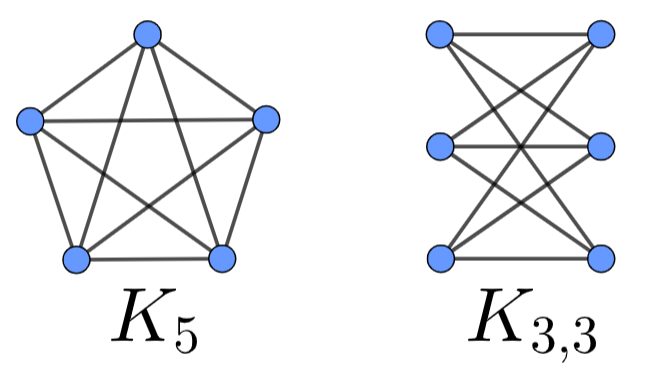Problems
Show that \(n^2+n+1\) is not divisible by \(5\) for any natural number \(n\).
Prove the following identity for any three non-zero real numbers \(a,b,c\): \[\frac{b}{2a} + \frac{c^2 + ab}{4bc} - \left|{\frac{c^2 - ab}{4bc}} \right| - \left|{\frac{b}{2a} - \frac{c^2 + ab}{4bc} + \left|{\frac{c^2 - ab}{4bc}}\right|}\right| = \min\{\frac{b}{a},\frac{c}{b},\frac{a}{c}\}.\]
In the picture below you can see the graphs of \(K_5\), the complete graph on \(5\) vertices, and \(K_{3,3}\), the complete bipartite graph on
\(3\) and \(3\) vertices. A theorem states that these
graphs cannot be embedded into plane, namely one cannot draw graphs
\(K_5\) and \(K_{3,3}\) on a plane in such a way that
there are no intersecting edges.
The question is: can you draw the graphs \(K_5\) and \(K_{3,3}\) without intersecting edges on a
torus?

Is it possible to link three rings together in such a way that they cannot be separate from each other, but if you remove any ring, then the other two will fall apart?
Prove that \(|x|\ge x\). It may be helpful to compare each of \(|3|\), \(|-4.3|\) and \(|0|\) with \(3\), \(-4.3\) and \(0\) respectively.
Let \(a\), \(b\) and \(c\) be the three side lengths of a triangle. Does there exist a triangle with side lengths \(a+1\), \(b+1\) and \(c+1\)? Does it depend on what \(a\), \(b\) and \(c\) are?
There is a triangle with side lengths \(a\), \(b\)
and \(c\). Can you form a triangle with
side lengths \(\frac{a}{b}\), \(\frac{b}{c}\) and \(\frac{c}{a}\)? Does it depend on what \(a\), \(b\)
and \(c\) are? Give a proof if it is
always possible or never possible. Otherwise, construct examples to show
the dependence on \(a\), \(b\) and \(c\).
Recall that a triangle can be drawn with side lengths \(x\), \(y\)
and \(z\) if and only if \(x+y>z\), \(y+z>x\) and \(z+x>y\).
There is a triangle with side lengths \(a\), \(b\)
and \(c\). Does there exist a triangle
with side lengths \(|a-b|\), \(|b-c|\) and \(|c-a|\)? Does it depend on what \(a\), \(b\)
and \(c\) are?
Recall that a triangle can be formed with side lengths \(x\), \(y\)
and \(z\) if and only if all the
inequalities \(x+y>z\), \(y+z>x\) and \(z+x>y\) hold.
There is a triangle with side lenghts \(a\), \(b\) and \(c\). Does there exist a triangle with sides of lengths \(a^2+bc\), \(b^2+ca\) and \(c^2+ab\)? Does it depend on the values of \(a\), \(b\) and \(c\)?
Prove that the set of all finite subsets of natural numbers \(\mathbb{N}\) is countable. Then prove that the set of all subsets of natural numbers is not countable.